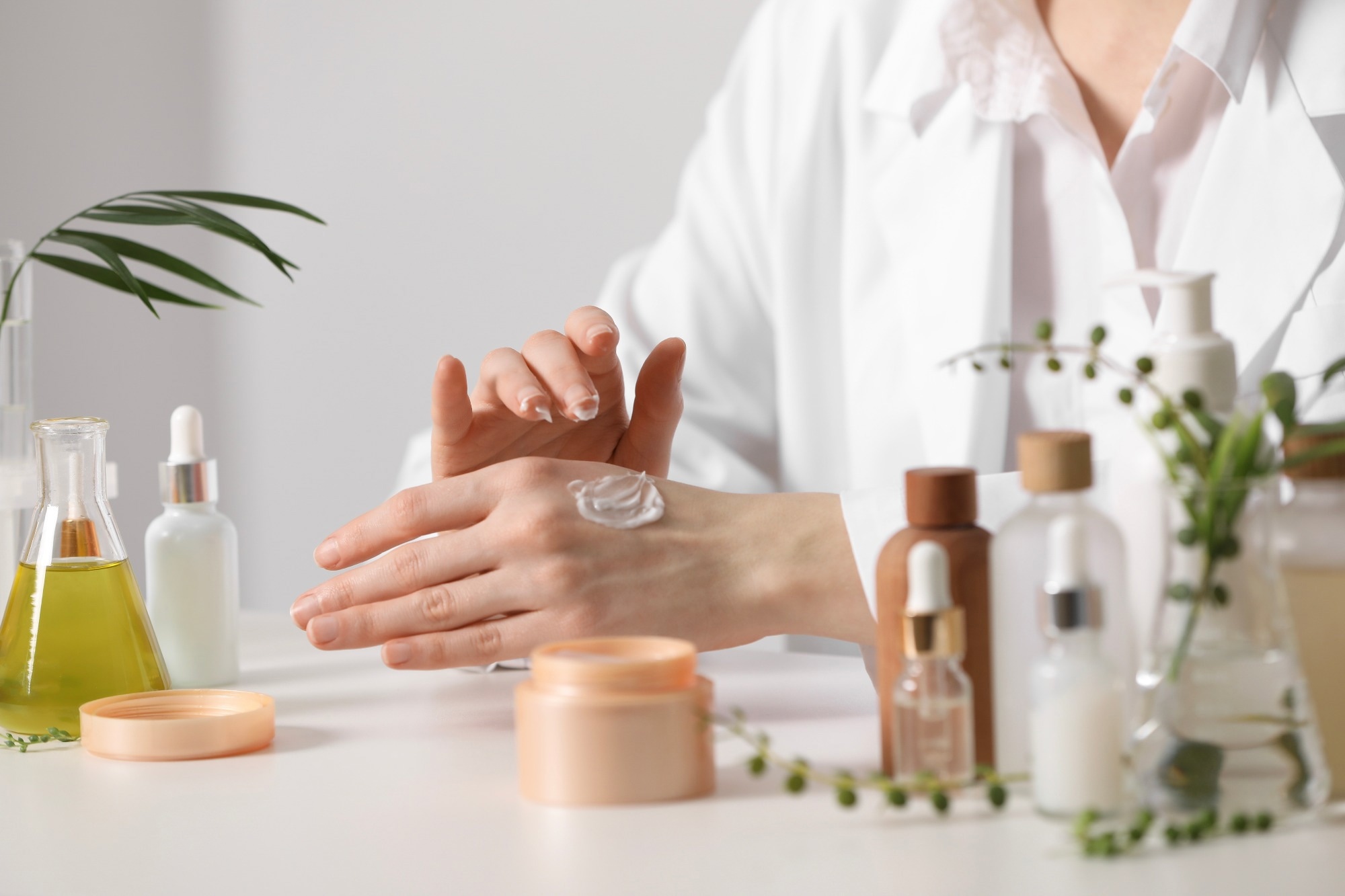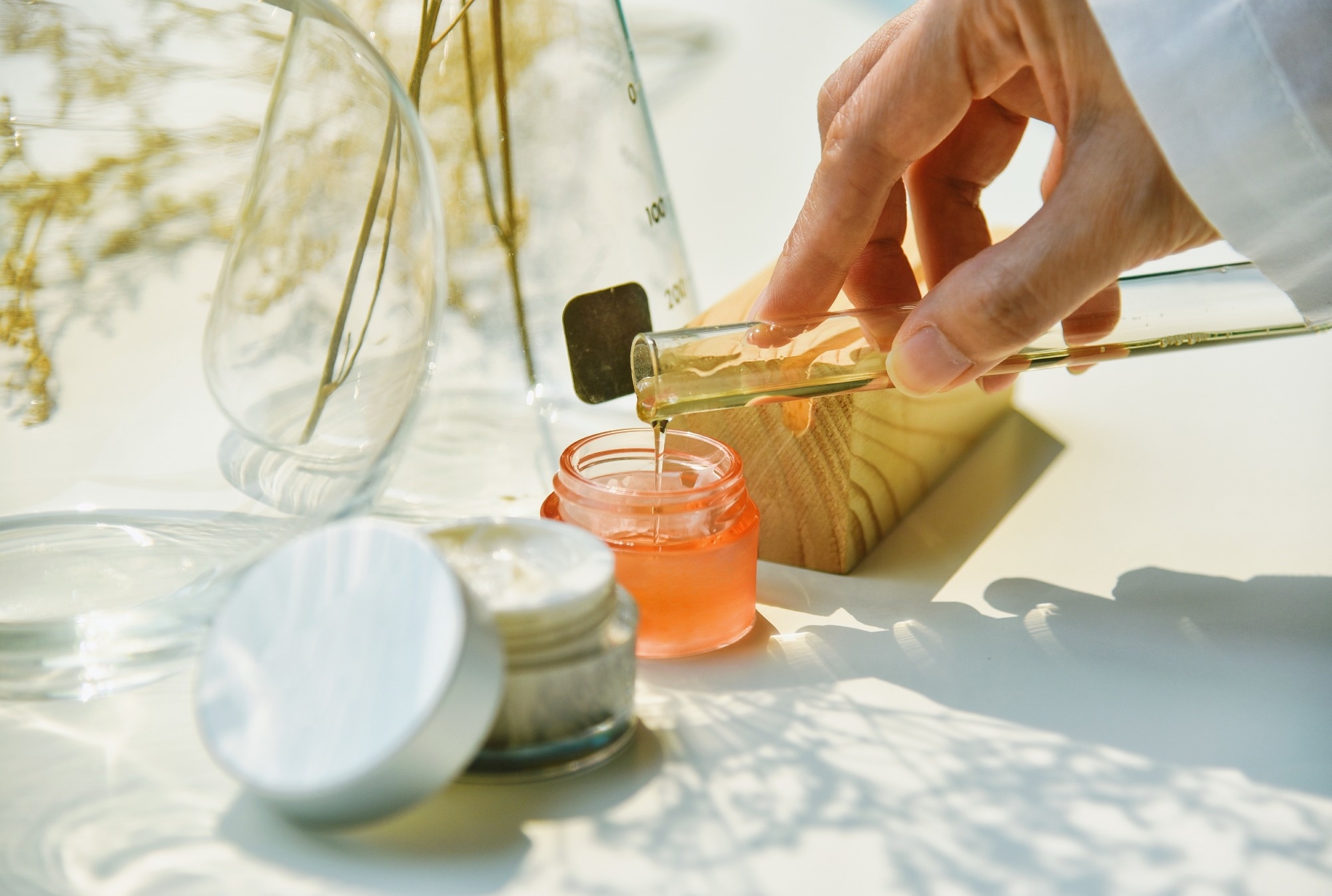Introduction
Niacinamide (Vitamin B3)
Retinol and retinoids
Other popular ingredients
Synergistic combinations and formulation considerations
Evidence gaps and areas for future research
Conclusion
References
Further reading
Explore the science behind today’s most popular skincare actives, from niacinamide to retinoids, and discover what truly works, what remains unproven, and how evidence-based choices are shaping the future of skin health.
 Image Credit: New Africa / Shutterstock.com
Image Credit: New Africa / Shutterstock.com
Introduction
Cosmeceutical ingredients now drive one of dermatology’s fastest-growing markets, as consumers and clinicians seek topical solutions that promise firmer, clearer skin. This rapid expansion, largely fueled by social media trends and accessible over-the-counter formulas, has outpaced rigorous scientific research, with many active ingredients entering medicine cabinets before trials verify their benefits or risks.
This article reviews the evidence on niacinamide (NAM), retinol, vitamin C, hyaluronic acid, peptides, and sunscreens, examining their benefits, safety, and research gaps.
Niacinamide (Vitamin B3)
Niacinamide (NAM), the water-soluble amide of vitamin B3, serves as a precursor for nicotinamide adenine dinucleotide (NAD⁺) synthesis. Both oral and topical niacinamide can increase intracellular NAD⁺ levels in skin cells, supporting cellular energy metabolism and DNA repair.
Topically applied niacinamide enhances epidermal NAD⁺ concentrations, which in turn support DNA repair and strengthen antioxidant defenses by increasing the availability of NADPH, a cofactor for the regeneration of reduced glutathione and other antioxidants.
In addition to modulating keratinocyte lipid output by stimulating the synthesis of ceramides, cholesterol, and free fatty acids to improve skin barrier function, niacinamide also inhibits the transfer of melanosomes from melanocytes to keratinocytes, thereby reducing hyperpigmentation.2
In reconstructed epidermis and human studies, 2-5% NAM upregulates ceramide, free fatty acid (FFA), and cholesterol production while increasing involucrin and filaggrin activity, all of which tighten the stratum corneum and improve hydration. A split-face study demonstrated that a 5% NAM moisturizer reduced hyperpigmented area more than a 2% formula, thus confirming dose-responsive lightening through slower melanosome transfer.2
The anti-inflammatory effects of NAM are attributed to its inhibition of nuclear factor kappa-light-chain-enhancer of activated B cells (NF-κB) and mitogen-activated protein kinase (MAPK) signaling, which reduces the expression of interleukin-6 (IL-6), IL-8, and prostaglandin E₂ (PGE₂). A 0.25% N-methylnicotinamide (N-MNA) gel has been shown to improve rosacea symptoms within four weeks, with NAM suppressing Cutibacterium acnes (C. acnes)-triggered cytokines relevant to acne. Randomized trials have similarly reported smoother texture, fewer wrinkles, and greater elasticity after twelve weeks of 5% NAM use.2
NAM is well-tolerated when used at a concentration of 5% in leave-on products, with adverse systemic effects only reported following high oral doses. The favorable safety profile of NAM justifies the routine inclusion of 2-5% concentrations in moisturizers, sunscreens, and serums for barrier support, pigment evening, anti-inflammatory care, and long-term skin resilience.2
Retinol and retinoids
Retinoids are in the vitamin A family and include retinol and retinaldehyde, as well as synthetic analogues like tretinoin (all-trans-retinoic acid), adapalene, tazarotene, and isotretinoin.
Retinoids share a conjugated backbone yet differ in their receptor affinity. For example, tretinoin activates all retinoic acid receptor (RAR) subtypes, whereas adapalene favors RAR-β/γ, producing fewer irritant reactions.
After binding cellular carriers, retinoids engage RAR/retinoid X receptor heterodimers that attach to retinoic acid response elements. This leads to the modulation of genes that control keratinocyte proliferation and differentiation, as well as collagen remodeling, which support cell turnover, a compact stratum corneum, thicker epidermis, and renewed dermal matrix.3
Placebo-controlled trials confirm that topical tretinoin 0.05-0.1% significantly smooths wrinkles, lightens mottled pigmentation, and increases collagen production between three and 12 months across diverse phototypes, with benefits persisting beyond one year. Adapalene gel diminishes actinic keratoses and brightens lentigines while maintaining excellent tolerability.
Retinol induces comparable epidermal thickening and collagen synthesis with minimal erythema. Isotretinoin alleviates photodamage and, as a result, is frequently used for the treatment of acne.3
Some limitations associated with retinoids include irritation, burning, and early photosensitivity, which are due to the induction of IL-8 and monocyte chemoattractant protein-1. To overcome these limitations, solid-lipid and polymeric nanoparticle formulations have been developed to protect retinol and tretinoin from photodegradation, localize drug accumulation within the epidermis, and reduce irritation in animal and volunteer studies. The continued development of receptor-selective analogs and nanocarriers will further support the advancement of gentle retinoid therapies for aging skin, acne, and pigmentary disorders.3
What Retinol Does and Why You NEED It!! | Dr Sam Bunting
Other popular ingredients
Topical vitamin C, which is otherwise known as ascorbic acid, is a potent antioxidant that scavenges ultraviolet (UV)-induced reactive oxygen species (ROS) while simultaneously up-regulating pro-collagen messenger ribonucleic acid (RNA). Randomized control trials have confirmed that daily 10% vitamin C serum reduces wrinkles and improves dermal collagen after 12 weeks, particularly when combined with broad-spectrum sun filters.4
Hyaluronic acid is a high-molecular-weight glycosaminoglycan that binds 1,000-fold its weight in water. Oral or injectable hyaluronic acid increases stratum corneum hydration, restores tight-junction proteins, and reduces the appearance of atrophic skin without inducing significant irritation in eight-week studies.4
Alpha-hydroxy acids (AHAs), such as glycolic and lactic acids, as well as the lipid-soluble beta-hydroxy acid (BHA) salicylic acid, dissolve corneodesmosomes to accelerate desquamation. Concentrations of 2-10% flatten hyperkeratotic plugs, fade lentigines, and stimulate dermal matrix renewal, all of which are ideal for managing acne and photoaged skin.5
Short bioactive peptides, typically six or fewer amino acids in length, mimic growth-factor sequences, signal fibroblasts to generate collagen types I and III, as well as exhibit antimicrobial or anti-inflammatory actions that accelerate wound closure in preclinical and early clinical studies. Sunscreens containing inorganic zinc oxide or organic filters counteract UV-A and UV-B radiation, thereby preventing deoxyribonucleic acid (DNA) mutagenesis, dyspigmentation, and 24% of new facial wrinkles in longitudinal cohorts while lowering melanoma incidence.6,7
Synergistic combinations and formulation considerations
Retinoids remain stable at a pH between five and six, with acidic bases causing degradation and alkaline vehicles preventing their uptake. Since patient response to retinoids is dose-dependent, yet irritation rises with strength, clinicians typically initiate a 0.025% tretinoin or 0.25% retinol treatment, then titrate while adding moisturizers that buffer pH and reinforce the skin barrier.
Maintaining formulation pH between five and six also preserves NAM integrity, which hydrolyzes outside the range. Encapsulation tools, including multilayer liposomes and nanostructured lipid carriers, create reservoirs that protect retinoids from light and support their slow delivery, thereby reducing erythema and dryness.9,10
Synergistic pairing amplifies benefits, as NAM supports ceramide synthesis and reduces inflammation. When combined with retinyl propionate, NAM provides more significant reductions in deep wrinkles than prescription tretinoin at equivalent study periods with superior tolerability.
Peptides, carob flavonoids, and antioxidants, such as Terminalia chebula polyphenols, complement retinol by stimulating collagen production and scavenging radicals, allowing clinicians to reduce retinoid doses without compromising efficacy. Formulators also blend gentler esters like retinyl acetate or retinyl palmitate with small retinol amounts to mimic the results of 0.02% tretinoin while minimizing dermatitis.
Glycerin- or ceramide-rich vehicles, nightly application, and daily broad-spectrum sunscreens complete a regimen that maximizes efficacy, controls irritation, and improves long-term patient adherence over time.9,10
 Image Credit: ARTFULLY PHOTOGRAPHER / Shutterstock.com
Image Credit: ARTFULLY PHOTOGRAPHER / Shutterstock.com
Evidence gaps and areas for future research
Most cosmetic products rely on small, open-label studies, with placebo-controlled, randomized controlled trials (RCTs) remaining scarce, especially for retinol esters, retinaldehyde, and new nano-carriers. Thus, multicenter RCTs powered to detect clinically meaningful differences in wrinkle depth, dyspigmentation, and barrier integrity are crucial.10
Irritation thresholds, pigment responses, and optimal dosing vary with age, phototype, and baseline barrier status. As a result, current guidance to ‘start low and titrate’ is empirical, rather than evidence-driven.
Stratified trials that pre-define cohorts by skin type, genetic polymorphisms such as retinoic acid receptor variants, or microbiome profiles are needed to clarify who benefits most from the treatment. These trials could also determine which patients may be at a greater risk of experiencing dermatitis or post-inflammatory hyperpigmentation.10
Long-term safety data are similarly limited, as only tretinoin has a two-year controlled study confirming sustained benefits without serious adverse events. Other retinoids and emerging nanoformulations lack data on chronic exposure, including the potential for these formulations to cause cumulative irritation, barrier alteration, or disrupted systemic absorption. Extended safety registries and real-world pharmacovigilance, coupled with in vitro and in silico toxicokinetic modeling, are urgently needed before these innovations can be confidently recommended for lifelong photoaging prevention.10
Conclusions
Evolving dermatologic research now offers accurate yet varied support for NAM, retinoids, vitamin C, hyaluronic acid, hydroxy acids, peptides, and broad-spectrum sunscreens. However, efficacy and tolerability remain dependent upon formulation, concentration, and individual biology.
Ultimately, an evidence-based and goal-oriented regimen maximizes therapeutic benefits, minimizes adverse reactions, and fosters patient confidence in modern cosmeceutical care for diverse age groups and backgrounds.
References
- Crous, C., Pretorius, J., & Petzer, A. (2024). Overview of popular cosmeceuticals in dermatology. Skin Health and Disease, 4(2), ski2-340. DOI: 10.1002/ski2.340, https://academic.oup.com/skinhd/article/4/2/ski2.340/7736686
- Boo, Y. C. (2021). Mechanistic basis and clinical evidence for the applications of nicotinamide (niacinamide) to control skin aging and pigmentation. Antioxidants, 10(8), 1315. DOI: 10.3390/antiox10081315, https://www.mdpi.com/2076-3921/10/8/1315
- Mukherjee, S., Date, A., Patravale, V., Korting, H. C., Roeder, A., & Weindl, G. (2006). Retinoids in the treatment of skin aging: an overview of clinical efficacy and safety. Clinical interventions in aging, 1(4), 327-348. DOI: 10.2147/ciia.2006.1.4.327, https://pubmed.ncbi.nlm.nih.gov/18046911/
- Boo, Y. C. (2022). Ascorbic acid (vitamin C) as a cosmeceutical to increase dermal collagen for skin antiaging purposes: emerging combination therapies. Antioxidants, 11(9), 1663. DOI: 10.3390/antiox11091663, https://www.mdpi.com/2076-3921/11/9/1663
- Moghimipour, E. (2012). Hydroxy acids, the most widely used anti-aging agents. Jundishapur journal of natural pharmaceutical products, 7(1), 9. https://pmc.ncbi.nlm.nih.gov/articles/PMC3941867/
- Md Fadilah, N.I., Shahabudin, N.A., Mohd Razif, R.A., Sanyal, A., Ghosh, A., Baharin, K.I., Ahmad, H., Maarof, M., Motta, A. and Fauzi, M.B., 2024. Discovery of bioactive peptides as therapeutic agents for skin wound repair. Journal of Tissue Engineering, 15, 20417314241280359. DOI: 10.1177/20417314241280359, https://journals.sagepub.com/doi/10.1177/20417314241280359
- Gabros, S., Nessel, T. A., & Zito, P. M. (2023). Sunscreens and photoprotection. In StatPearls [Internet]. StatPearls Publishing. https://www.ncbi.nlm.nih.gov/books/NBK537164/
- Milosheska, D., & Roškar, R. (2022). Use of retinoids in topical antiaging treatments: a focused review of clinical evidence for conventional and nanoformulations. Advances in therapy, 39(12), 5351-5375. DOI: 10.1007/s12325-022-02319-7, https://link.springer.com/article/10.1007/s12325-022-02319-7
- Handler, M., Adams-Woodford, A., Ayres, P., Giancola, G., & Diaz, I. (2022). Facial Aging Improvement Case Study Using a Novel Combination of Retinol, Niacinamide, and Terminalia Chebula. Journal of drugs in dermatology: JDD, 21(7), 784-788. DOI: 10.36849/JDD.6621, https://jddonline.com/articles/facial-aging-improvement-case-study-using-a-novel-combination-of-retinol-niacinamide-and-terminalia-chebula-S1545961622P0784X/
- Milosheska, D., & Roškar, R. (2022). Use of retinoids in topical antiaging treatments: a focused review of clinical evidence for conventional and nanoformulations. Advances in therapy, 39(12), 5351-5375. DOI: 10.1007/s12325-022-02319-7, https://link.springer.com/article/10.1007/s12325-022-02319-7
Further Reading
Last Updated: Jul 7, 2025